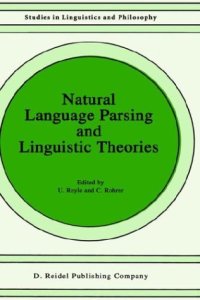
Ebook: Natural Language Parsing and Linguistic Theories
- Genre: Linguistics
- Tags: Computational Linguistics, Syntax, Artificial Intelligence (incl. Robotics)
- Series: Studies in Linguistics and Philosophy 35
- Year: 1988
- Publisher: Springer Netherlands
- City: Dordrecht; Boston :, Norwell, MA, U.S.A
- Edition: 1
- Language: English
- djvu
presupposition fails, we now give a short introduction into Unification Grammar. Since all implementations discussed in this volume use PROLOG (with the exception of BlockjHaugeneder), we felt that it would also be useful to explain the difference between unification in PROLOG and in UG. After the introduction to UG we briefly summarize the main arguments for using linguistic theories in natural language processing. We conclude with a short summary of the contributions to this volume. UNIFICATION GRAMMAR 3 Feature Structures or Complex Categories. Unification Grammar was developed by Martin Kay (Kay 1979). Martin Kay wanted to give a precise defmition (and implementation) of the notion of 'feature'. Linguists use features at nearly all levels of linguistic description. In phonetics, for instance, the phoneme b is usually described with the features 'bilabial', 'voiced' and 'nasal'. In the case of b the first two features get the value +, the third (nasal) gets the value -. Feature value pairs in phonology are normally represented as a matrix. bilabial: + voiced: + I nasal: - [Feature matrix for b.] In syntax features are used, for example, to distinguish different noun classes. The Latin noun 'murus' would be characterized by the following feature-value pairs: gender: masculin, number: singular, case: nominative, pred: murus. Besides a matrix representation one frequently fmds a graph representation for feature value pairs. The edges of the graph are labelled by features. The leaves denote the value of a feature.
Linguistic theories play an important role in natural language processing applications. This volume contains several detailed studies of questions concerned with the implementation of contemporary grammatical theories (LFG, GPSG, CUG, GB) as well as their application to the formal description of natural languages. The linguistically-oriented studies concentrate on word order, non-local dependencies and coordination, and on the relation between syntax and semantics. A second set of contributions investigates how desirable properties of linguistic formalisms (such as restrictiveness, decIarativeness, rigor, and linguistic felicity) can be maintained without sacrificing computational efficiency or leading to excessive computational complexity. These papers show clearly that theoretical and computational linguistics can make significant contributions to each other. The studies that focus on implementational issues discuss the aspects of linguistic theories that should be incorporated in natural language processing systems and describe attempts to provide efficient and flexible implementations of systems based on these theories.